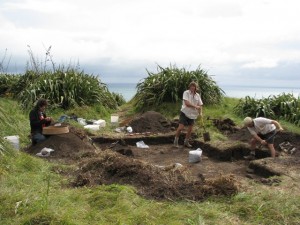 A recent archaeological dig at Te Ahua pa (Q11/61) above Mercer Bay found a plethora of artefacts and materials that add to our knowledge of how Maori lived around Piha in the mid to late 15th century.
A recent archaeological dig at Te Ahua pa (Q11/61) above Mercer Bay found a plethora of artefacts and materials that add to our knowledge of how Maori lived around Piha in the mid to late 15th century.
The dig was carried out by Auckland Regional Council and Auckland University and volunteer archaeologists as a condition of the consent to rebuild the path down to Te Ahua Point with a look-out platform. (This is spectacular and well worth a visit if you have not been there recently. You are literally hanging 175 metres above the sea).
In 1977 Bruce Hayward and Jack Diamond recorded five terraces, a storage pit and shell and fish bone midden on the site, but this has been covered up by dense coastal vegetation.
Seventy-five artefacts were found in the recent excavation, mostly stone flakes relating to adze manufacture, and all but a few were basalt probably from a source nearby, such as Maori Bay at Muriwai. Other flakes came from the Hauraki Gulf islands and another was of Nelson/Marlborough argillite. Several chert drillpoints and reaming tools were probably used to work bone fishhooks, and there were obsidian flakes from Mayor Island.
The shellfish and bones found on the site tell us what the inhabitants were eating. Seven bone fishhooks were found, and the shellfish remnants found on the site showed that the inhabitants were eating tuatua, mussels and white rock shells. Over three kilos of bone were recovered from the midden, mostly fish – eight species, mainly schnapper, blue moki and trevally – which would have been the predominant part of the inhabitants’ diet, sea birds ” mainly juvenile fluttering shearwater which were probably preserved, and spotted shag. Sixty grams of moa bones were found, and small amounts of dog bones.
Charcoal analysis shows that a wide range of coastal vegetation was present, not dissimilar to what we find along the coast today, with trees such as pohutukawa, kohekohe, kowhai and kauri.
The archaeologists’ discussion states that the wide range of food sources shows the inhabitants were not under economic pressure, but they theorise as to why they would have chosen to live at such a difficult location, as opposed to living on the coast close to fresh water, the sea and their canoes. The Te Ahua pa had formidable natural defences, with steep cliffs on three sides, so a human threat seems possible, but the archaeologists come down on the side of a theory for an environmental threat. Evidence suggests there was at least one tsunami in the 15th century and the archaeologists postulate that this may have been the cause of these ancient people choosing to live so high above sea level.


